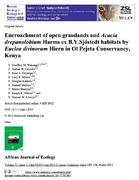| dc.description.abstract | Euclea divinorum, a fast establishing, unpalatable, and fire resistant bush is considered an invasive species in some parts of its range. In Ol Pejeta Conservancy (OPC), Kenya, E. divinorum bushes cover ˜27% of the total area (˜9470 ha.) and has been expanding in coverage and encroaching into A. drepanolobium woodlands, a key woody habitat for the endangered black rhino. Between 2006 and 2010, we assessed the spatial distribution, annual rates of spread and recruitment of E. divinorum in OPC. We used data from satellite imagery and belt transects laid at the transition between E. divinorum habitat and other habitats. Density of E. divinorum seedlings increased by 27% annually over five years, with more seedlings establishing in grassland habitat (56.6%) than in A. drepanolobium woodland (43.4%). Within the infection frontier, the number of seedlings was high at the ecotone and reduced predictably with an increase in distance into the infection zone. Increase in rainfall facilitated recruitment and survival of E. divinorum seedlings and also reduced damage on trees and seedlings by mega-herbivores, especially elephants. This study confirms the encroachment of E. divinorum bushland into other habitats. This has been accelerated by burning and damage to A. drepanolobium habitat thus opening it up to encroachment by E. divinorum. | en_US |
